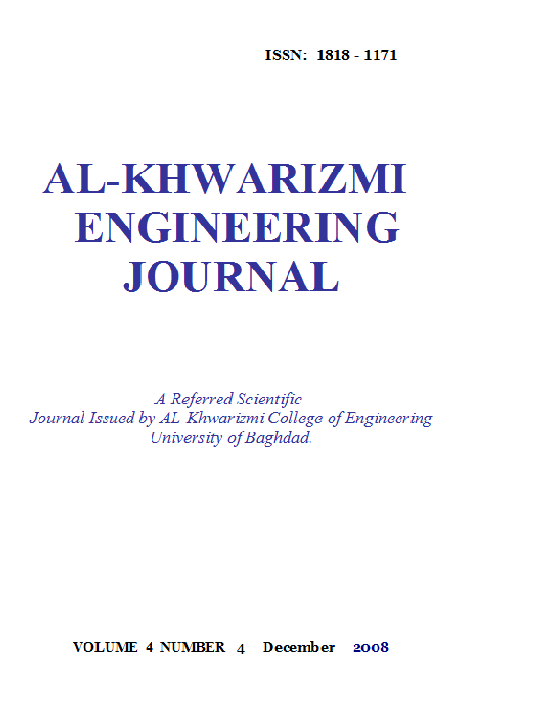Large Angle Bending Behavior of Curved Members Using The Method of Characteristics
Abstract
This paper deals with the nonlinear large-angle bending dynamic analysis of curved beams which investigated by modeling wave’s transmission along curved members. The approach depends on the wave propagation in one-dimensional structural element using the method of characteristics. The method of characteristics (MOC) is found to be a suitable method for idealizing the wave propagation inside structural systems. Timoshenko’s beam theory, which includes transverse shear deformation and rotary inertia effects, is adopted in the analysis. Only geometrical non-linearity is considered in this study and the material is assumed to be linearly elastic. Different boundary conditions and loading cases are examined.
From the results obtained, it is found that the geometrical shape, boundary conditions, material properties of the members as well as the load type and direction have considerable effects on the response of the member.
Downloads
References
[2] Ahmed, N. S., "Large-Angle Bending Dynamic Analysis of Slender Beams", M.SC. Thesis, University of Baghdad, Department of Civil Engineering, Baghdad, Iraq, 2003.
[3] Al-Mousawi, M. M., Harrison, H. R., and Gosh, S. K., "On Numerical Solution Methods for Flexural Waves in Stepped Beams", International Journal of Impact Engineering, Vol. 7, No. 3, 1988, p.p. 327-343.
[4] Al-Da'ami, H. H., "Transient Response of Systems with Non-Prismatic Members by Characteristics" M.Sc. Thesis, Saddam University of Engineering and Science, Baghdad, Iraq, 1992.
[5] Ali, A. A., "Nonlinear Analysis of Structures with Prismatic or Nonprismatic Members Under Static and Dynamic Loading", M.SC. Thesis, University of Technology, Department of Building and Construction, Baghdad, Iraq, 1999.
[6] Al Sarraj, A.T., "Mrethod of Characteristics Analysis of Vibrating Frames and Trusses", Ph.D. Thesis, The University of Dundee, Department of Civil Engineering ,Dundee, U.K., 1989.
[7] Chan, "Structure Analysis of Trusses and Frames", Ph.D. Thesis, The University of Dundee, Department of Civil Engineering ,Dundee, U.K., 1983.
[8] Thomson, W. T., "Impulsive Response of Beams in the Elastic and Plastic Regions", Journal of Applied Mechanics, Vol. 21, 1954, p.p. 271-278.
[9] Timoshenko, S. P., "On the Transverse Vibrations of Bars of Uniform Cross Section", Philosophical Magazine, Vol. 6, No. 43, 1922, p.p. 125-131.
[10] Timoshenko, S. P., and Goodier, J. N., "Theory of Elasticity", 3rd Edition, McGraw-Hill Book Co., Inc., New York, 1982.
[11] Timoshenko, S. P., Young, D. H., and Weaver, W. J., "Vibration Problem in Engineering", 4th Edition, John Wiley & Sons, Inc., New York, 1974.
Published
Issue
Section
License
Copyright: Open Access authors retain the copyrights of their papers, and all open access articles are distributed under the terms of the Creative Commons Attribution License, which permits unrestricted use, distribution, and reproduction in any medium, provided that the original work is properly cited. The use of general descriptive names, trade names, trademarks, and so forth in this publication, even if not specifically identified, does not imply that these names are not protected by the relevant laws and regulations. While the advice and information in this journal are believed to be true and accurate on the date of its going to press, neither the authors, the editors, nor the publisher can accept any legal responsibility for any errors or omissions that may be made. The publisher makes no warranty, express or implied, with respect to the material contained herein.












